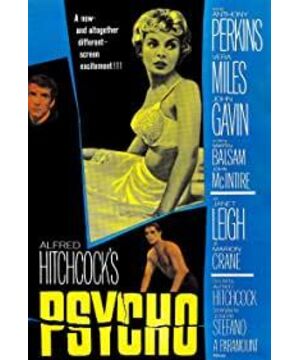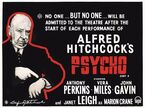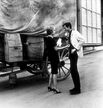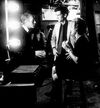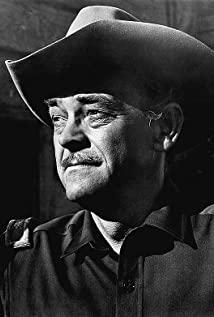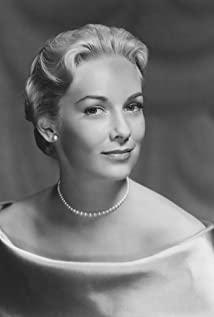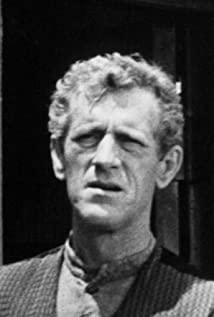The classics of "Scary" lies in two points: reasonable and refined narration, stylized and subtle lens language, and the advancement of the narrative is completed by the lens language.
The whole narrative is smooth, logically rigorous, and there is no extra plot or dialogue.
Marion works in Phoenix, and has a hurried tryst with her boyfriend in a cheap hotel at noon, but her boyfriend has not divorced his ex-wife due to alimony issues. Marion went to work with a depressed mood, and it happened that the boss asked him to deposit $40,000 in the bank. On impulse, Marion ran away with the money.
Along the way, Marion, who was a guilty conscience, felt that the police had found something and followed it up. She changed the car and continued on, and finally came to a secluded motel, preparing to fix it all night.
There were no people around the hotel, except for the seemingly harmless owner Norman and his mother, who only heard his voice and never showed up. Unexpectedly, Marion was killed in the bathroom.
Later, the detective intervened in the matter and went to the hotel to investigate and was accidentally killed. Marion's sister and boyfriend noticed that the matter was strange and went to investigate.
In the end, the two targeted Norman, working together, and thrilling to take Norman, and found that in fact, a patient with split personality, his mother had already died, and the mother in his mouth was just a personality he split.
This kind of plot is obviously not amazing enough for today, but Hitchcock's narrative is very concise, the lens language is exquisite and profound, and it can create a thrilling atmosphere.
Let's take an example.
1. The subjective lens editing exaggerates the inner tension of the protagonist and creates a nervous atmosphere
This is mainly reflected in Marion's desperate journey, which the police tracked all the way. Marion saw the police car chasing after him in the rearview mirror. When changing the car, he saw the police staring at him on the other side of the road. His eyes were full of fear, his behavior was awkward and restless.
Of course, this is not the case, and Marion's psychology may be at work. It's just that the subjective perspective and sound effects exaggerate his inner anxiety. (Of course, the actor Janet Leigh’s eyes, facial expressions and language expressions are also in place to show the character's psychology).
2. The sound and picture are not right, show the inner activities of the characters, set off the tension and cleverly retain suspense.
The misalignment of sound and picture appeared twice in the whole film.
It also appeared on Marion's escape, and the driving scene was matched with the dialogue between the boss and the subordinates, and the dialogue between the police and the boss of the car dealer. Set off Marion's tension.
The second sound and picture misalignment appeared when Norman and his mother (which did not actually exist) were talking in the room. The picture showed the aisles and stairs outside the room. This is because the suspense was not revealed at the end, and the true identity of the mother was not revealed. In order to preserve the suspense, the mismatch of sound and picture was used here, and only the sound was heard, allowing the audience to leave room for imagination.
3. Classical expressions of classic passages
1. Killing in the bathroom
Murder in the bathroom is a classic passage praised and imitated by later generations in "The Terror", and it also best highlights Hitchcock's master style.
Unlike today's horror films, "Scary" does not present bloody scenes, and there is no strong visual impact. The film still chooses black and white tones; there is no eerie sound effect, only a sharp and piercing soundtrack.
Let's analyze the specific shots below.
At first, Marion was very enjoyable, as if he was shooting a shower gel commercial...
When the black shadow holding the murder weapon opened the shower curtain. (To preserve suspense, the murderer is just a backlit silhouette, but the silhouette of the murder weapon is very sharp.)
Marion's expression changed suddenly, forming a very sharp contrast with the previous one.
During the assault, the cross-editing of the murderer and Marion highlights the chaos of the scene. The murderer was shot at an elevation angle. On the one hand, it is Marion's subjective perspective. On the other hand, it highlights that the dark and gloomy atmosphere is overwhelming and difficult to contend. Marion is weak and death is irresistible.
The assaulted Marion used close-ups of his mouth, hands, and feet, which was very expressive.
At the end of the murder, a gradual dissolving lens was used to show Marion's death. The lens cuts into Marion's stagnant eyeballs from the drain where the blood flows.
This classic passage is very shocking, and colleagues have also proved the importance of scene scheduling and artistic techniques for creating horror effects.
Of course, everyone did not expect that the heroine would jump on the street before halfway through the film...
2.Norman sunk
After the heroine went offline, the protagonist of the film also secretly switched and became the hotel owner Norman. During Marion, Norman carefully cleaned up the crime scene, and finally loaded the heroine into the car and sank into the swamp.
A cross-editing method of subjective perspective is adopted here, which allows the audience to watch the sunken car with Norman's sight; on the other hand, it presents Norman's expression changes during the whole process of watching the sunken car.
So when the car suddenly stopped before it sank completely, Norman's expression was very disturbed, everyone would squeeze sweat with him...;
When the car continued to sink, Norman had a weird and sly smile on his face. It can be said that the portrayal of the characters by the actor Anthony Perkins is quite delicate and layered.
3. The detective was killed
Norman is now the biggest suspect, and Marion will not die for no reason. How does the story advance? At this time, the detective who was eager for the truth came online.
If you don't die, you won't die, which is the usual routine of horror movies. If Marion didn't die and came to a remote hotel, he wouldn't be thrown away in the wilderness. Similarly, if the detective wasn't curious about Norman's mother, he wouldn't be brutally killed.
Let's take a look at the whole process of the detective's death.
The detective stepped closer to the haunted house where the "mother" lived, trying to find out. When going up the stairs, the door of the room opens. There is no photograph of the person coming out of the door of the room, but the change of light is used to show this process.
Then, the "mother" quickly walked out and cut directly at the detective with a knife. This process was so fast that people were caught off guard, and a bird's-eye lens was used to shoot at a depression angle, highlighting the detective's helplessness and his tragic fate.
The above is a look at how Hitchcock creates a thrilling atmosphere from the lens, editing and other performance techniques. But this is really not enough. A classic suspense and thriller is also inseparable from the excellent performance of the actors, the coordination of sound and sound effects, and the setting of the environment.
Janet Leigh naturally doesn't have to say much about Marion's interpretation, her eyes can speak. And Anthony Perkins's interpretation of the complexity and contradiction of Norman's role is even better (as can be seen from the changes in the expression of the sunken car in the front).
In addition, the contrast from the face-to-face confrontation with Marion and the detective, the honesty and youthfulness of the conversation to the side of the murderer who was possessed by the "mother" after the split, is really amazing.
Who would have thought that this boy with nice people on his face would be a terrible murderer?
Especially in the last scene of the film, it merges with the personality of the mother. Everyone feels the change in Norman's expression.
No... I have a nightmare...
In terms of sound effects, the most outstanding part is also when Norman and "Mother" were combined together. The screen is Norman but the old voice comes from the mother. This misalignment adds to the horror of the film.
In terms of environment, the specimens of live birds in the room where Norman invited Marion to eat create a tense and terrifying look.
Finally, let me talk about the motive of the murder.
This film can be regarded as a model of horror film, but there is still a criticized part, which is the analysis of the motives of murder by the police. Personally, I think it's a bit redundant, and it's too straightforward and true, leaving the audience to think less.
After all, movies can raise questions, but they don’t have to give answers.
View more about Psycho reviews


